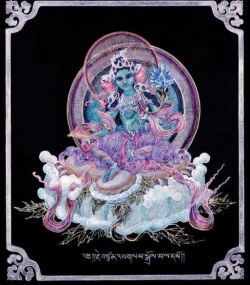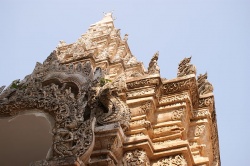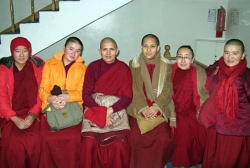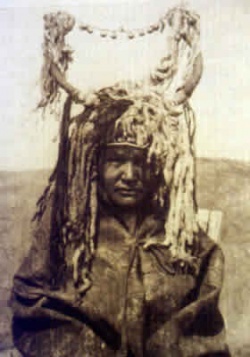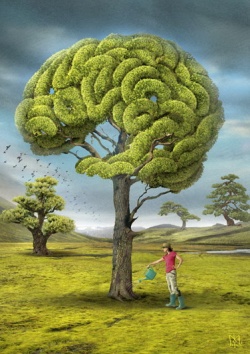Samantabhadra Contemplation Sutra
Samantabhadra Contemplation Sutra
(Taisho Tripitaka 0277)
Translated into Chinese during Song Dynasty by Dharma-mita
Translated into English by B.T.T.S.
Thus I have heard: Once the Buddha was staying at Vaisali, in the multi-storied assembly hall in the Great Forest Monastery. Then he told all the Bhikshus, saying, "After three months, I shall surely enter Parinirvana."
Thereupon the Venerable Ananda rose from his seat, straightened his garment, and with joined palms and folded hands, circumambulated the Buddha three times and bowed to him, then knelt down with palms together. He attentively gazed at the Tathagata without turning away his eyes for a moment.
The Elder Mahakasyapa and the Bodhisattva, Mahasattva, Maitreya also rose from their seats, and with palms together bowed to him and gazed up at his honored countenance.
Then the three great leaders spoke in unison to the Buddha, saying: "World Honored One! After the Nirvana of the Tathagata, how can living beings bring forth the resolve of the Bodhisattva, practice the Expansive Sutras, the Great Vehicle, and ponder the world of Uniform Reality with right thought? How can they keep from losing their resolve for the Supreme Bodhi?
How, without cutting off their earthly cares and renouncing their Five Desires, can they also purify their sense organs and destroy their offenses?
How, with the natural pure eyes received at birth from their parents and without leaving the world of the Five Desires, can they see all impediments, just as they are?"
The Buddha said to Ananda: "Listen to me attentively! Listen to me attentively! Consider what I am about to say, and remember it well! In the past on Vulture Peak and in other places, the Tathagata has already thoroughly explained the Way of Uniform Reality.
But now in this place, for all living beings and others in the worlds to come who desire to cultivate the supreme Dharma of the Great Vehicle, and to those who desire to learn the Practices of Universal Worthy and to cultivate the Practices of Universal Worthy, I will now speak this Dharma of contemplation.
For all those who get to see Universal Worthy, as well as for those who do not see him, I will now explain for you in detail how to eliminate numerous offenses.
"Ananda! The Bodhisattva Universal Worthy was born in the Eastern Land of Pure Wonder. I have already described the features of his country in detail in the Dharma Flower Sutra. Now I will briefly explain them again.
"Ananda! If there be Bhikshus, Bhikshunis, Upasakas, Upasikas, Gods, Dragons and the Eight-fold Pantheon, or any living beings who recite Great Vehicle Sutras, if there are those who cultivate the Great Vehicle, aspire to it, delight to see the form and body of the Bodhisattva Universal Worthy, find pleasure in seeing the stupa of the Buddha Abundant Treasures, take joy in seeing Sakyamuni Buddha and the Buddhas who emanate from him, and rejoice to obtain the purity of the six sense organs, then they must learn this contemplation.
The merits of this contemplation will make them free from all hindrances and allow them to see the Buddhas' fine and sublime form.
Even though they have not yet entered into samadhi, just because they recite and keep the Great Vehicle they will devote themselves to practicing it,
and after having kept their minds continuously on the Great Vehicle for one day, or for three times seven days, they will be able to see Universal Worthy.
Those who have heavy obstacles will see him after seven times seven days; again, those who have heavier obstacles will see him after one rebirth. Again, those who have much heavier obstacles will see him after two rebirths;
further, those who have still heavier obstacles will see him after three rebirths.
Thus the retribution of their karma differs; it is not equal. Thus I speak the teaching expediently."
"The Bodhisattva Universal Worthy is boundless in the size of his body, boundless in the sound of his voice, and boundless in the form of his image.
Desiring to come to this world, he makes use of his sovereign psychic powers and compresses his stature to a smaller size.
Because the people in Jambudvipa have the Three Weighty Obstacles, by the power of his wisdom he appears by transformation as mounted on a white elephant. The elephant has six tusks, and seven limbs, (supports its body on the ground?).
Under its seven limbs, seven lotus flowers grow.
The elephant is white as snow, the most brilliant of all shades of white, so pure that even crystal and the Himalaya Mountains cannot compare with it.
The body of the elephant is four hundred and fifty yojanas in length and four hundred yojanas in height.
At the tip of the six tusks rest six bathing pools. In each bathing pool grow fourteen lotus flowers as large as the pools. The flowers bloom majestically, like the king of celestial trees.
On each of these flowers sits a jade maiden whose countenance is red as crimson and whose radiance surpasses that of a goddess.
In the hand of that maiden five harps appear by transformation, each of them with five hundred musical instruments as its accompaniment.
Five hundred birds fly up, including ducks, wild geese, and mandarin ducks, in color like precious gems, and settle among flowers and branches.
On the elephant's trunk there is a flower with a stalk the color of a red pearl. Its blossom is golden, its shape is still a bud that has not yet blossomed.
After witnessing this event, if a person further repents of his offenses, and contemplates the Great Vehicle attentively, with entire devotion, and ponders it in his mind without cease, he will be able to see the flower spontaneously bloom, and radiate with a golden color.
The blossom of the lotus flower is made of kimsuka gems en laid with wonderful, pure Mani jewels; the stamens are made of diamond.
A transformation Buddha appears, sitting on the petals of the lotus flower with a host of Bodhisattvas sitting on the stamens.
From the eyebrows of the transformation Buddha a ray of light appears and enters the elephant's trunk.
This ray, the color of a red lotus flower, emanates from the elephant's trunk and enters its eyes; the ray then shines from the elephant's eyes and enters its ears; it then comes from the elephant's ears, illuminates its head, and changes into a golden platform.
On the elephant's head there are three transformed attendants: one holds a golden wheel, another a jewel, and another a vajra pestle. When the attendant raises the pestle and points it at the elephant, the latter immediately walks (a few steps?).
The elephant does not tread on the ground but hovers in the air, seven feet above the earth, yet the elephant leaves its footprints on the ground. The footprints are altogether perfect, marking the wheel's hub with a thousand spokes. From each hallmark of the wheel's hub grows a great lotus flower, upon which an elephant appears by transformation.
This elephant also has seven legs and walks after the great elephant. Every time the transformed elephant raises and brings down its legs, seven thousand elephants appear, all following the great elephant as its retinue.
On the elephant's trunk, in hue like a red lotus flower, sits a transformed Buddha who emits a ray from his eyebrows.
This ray of light, in similar fashion, enters the elephant's trunk. The ray emerges from the elephant's trunk and enters its eyes; the ray then shines from the elephant's eyes and again enters its ears; it then comes from the elephant's ears and reaches its head.
Gradually rising to the elephant's back, the ray is transformed into a golden saddle which is adorned with the Seven Precious Gems.
On the four sides of the saddle are the pillars made of the Seven Precious Gems, which are decorated with precious objects, forming a jeweled pedestal. On this pedestal there is a lotus flower stamen bearing the Seven Precious Gems, and that stamen is also composed of a hundred jewels. The blossom of that lotus flower is made of a great Mani-jewel.
On the top there is a Bodhisattva, called Universal Worthy, who sits cross-legged, whose body, pure as a white jewel, radiates fifty rays of fifty different colours forming a brightness around his head. From the pores of his body he emits rays of light and innumerable transformed Buddhas are at the ends of the rays accompanied by the transformed Bodhisattvas as their retinue.
The elephant walks quietly and slowly and goes before the follower of the Great Vehicle, raining large jewelled lotus flowers. When this elephant opens its mouth, the precious daughters dwelling in the bathing pools on the elephants tusks, play music whose sound is mystic and extols the Way of One Reality in the Great Vehicle.
Having seen this wonder, if a follower rejoices and reveres again, further reads and recites the profound sutra, salutes universally the Buddhas in all directions, makes obeisance to the stupa of the Buddha Abundant Treasures, and Shakyamuni Buddha, salutes Universal Worthy, and all the other great Bodhisattvas, then the follower makes this vow:
Had I received some blessings through my former destiny, I could surely see Universal Worthy. Be pleased, Universal Fortune, to show me your form and body.
(......)
